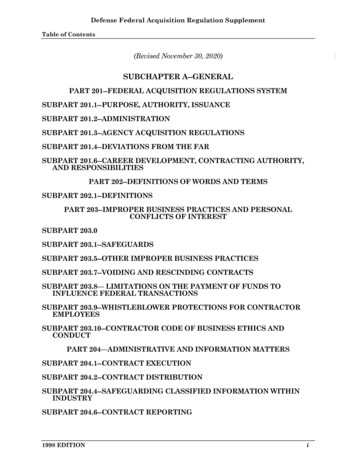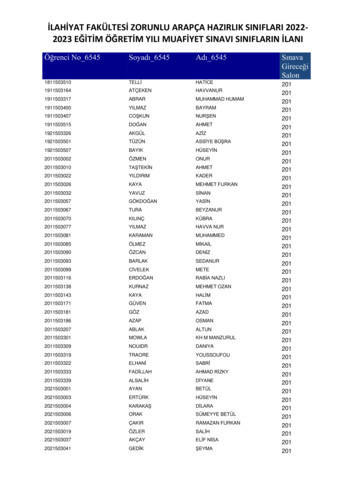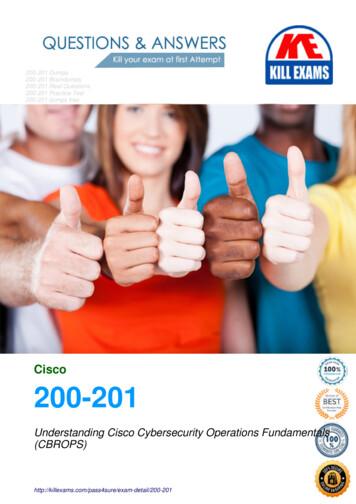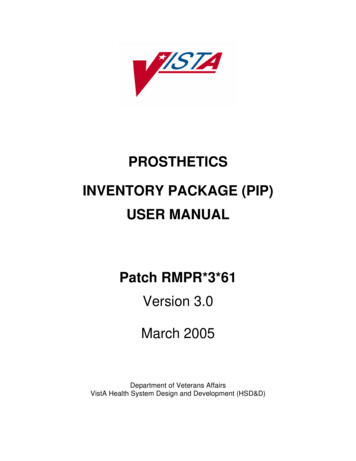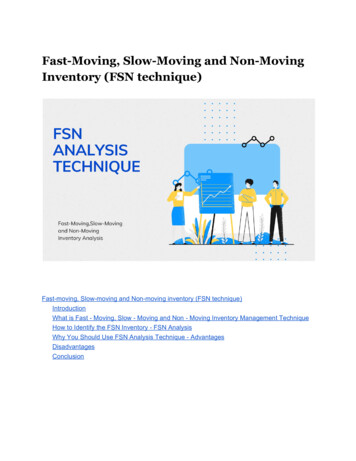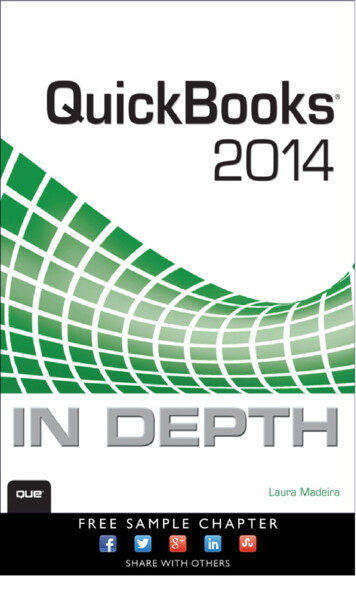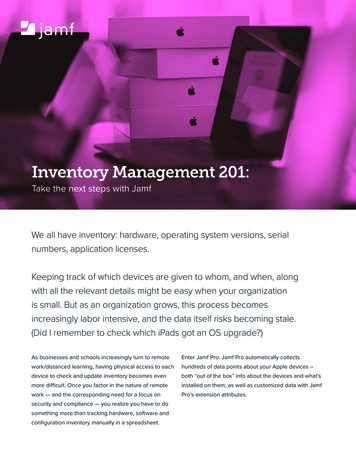
Transcription
Inventory Management 201:Take the next steps with JamfWe all have inventory: hardware, operating system versions, serialnumbers, application licenses.Keeping track of which devices are given to whom, and when, alongwith all the relevant details might be easy when your organizationis small. But as an organization grows, this process becomesincreasingly labor intensive, and the data itself risks becoming stale.(Did I remember to check which iPads got an OS upgrade?)As businesses and schools increasingly turn to remoteEnter Jamf Pro. Jamf Pro automatically collectswork/distanced learning, having physical access to eachhundreds of data points about your Apple devices –device to check and update inventory becomes evenboth “out of the box” info about the devices and what’smore difficult. Once you factor in the nature of remoteinstalled on them, as well as customized data with Jamfwork — and the corresponding need for a focus onPro’s extension attributes.security and compliance — you realize you have to dosomething more than tracking hardware, software andconfiguration inventory manually in a spreadsheet.
Inventory should start with enrollmentFrom the moment a user touches a device, your inventorysoftware should be collecting information on the device andplacing it into an easily accessible database by apps, device type,OS, permissions and packages.The best way to do this for Apple devices is to pre-enroll yourdevices with Apple Business Manager, and ensure that Jamf Procan continue to automate device tracking throughout the life ofthat device.Once you have all of this information Jamf Pro has gathered, youcan take action based on all manner of inventory data.What is inventory management?A brief recap of ideas and termsComputer inventory management is a set of best practicesand workflows that track an organization’s IT devices and theircontents. The best inventory management should answer thesequestions for you and more: How many devices do you actually have? What types ofdevices? Are they all in use, or are some simply stacked in a closet,depreciating? Are all of your organization’s devices up to date? Which apps are on which devices? Who has access to what? Does anyone have an overloaded machine, hasn’t updatedtheir password or hasn’t performed a backup? Is your fleet secure? Are you meeting all of your CISbenchmarks? Who has required protection software, such as Jamf Protect,and who has not?
Inventory management termsFleet: all of the devices you're managing (macOS, iOS, iPadOS and tvOS devices).Inventory: attributes of your fleet of devices, such as: Device Type: MacBook Pro, iPad, iPhone, Apple TVs FileVault 2 Partition Encryption State: Encrypted, Not Encrypted Last Inventory Update: (this will show the date/time the device last updated information)Static Groups: devices in groups chosen manually by an administrator; the membership does notchange unless the admin changes it intentionally.Smart Groups: devices in Smart Groups change dynamically based on criteria pulled frominventory. For example, you could create a Smart Group for "Find all macOS devices that areFileVault encrypted" or "find iPads running any version of iOS 14.” As your fleet changes, yourSmart Group memberships change based on how they fit into that criteria, automatically.Extension attributes: additional inventory data populated manually or via a script. A fewexamples: “a date field reflecting the date a device was retired from inventory” (this could bemanually entered as a part of the deprovisioning workflow) or “an integer field detailing the binaryversion of a tool/app that normally isn’t reflected in the Applications folder” (populated via scriptand dynamically changed whenever the app is updated).Scope: defining which devices receive which management components (apps, configurations,policies, restrictions, etc.)Configuration profiles: settings that use Apple's mobile device management (MDM) frameworkand cannot be changed by end users (i.e. "deploy a setting to require the macOS screen saverstarts after 15 minutes of inactivity" or "deploy the office Wi-Fi settings to all iPads). You canmanage iOS, iPadOS and tvOS entirely by profiles.Policies: settings and application deployments for macOS devices that fall outside the MDMframework. The Jamf binary handles policies and accounts for the things that MDM doesn’t do formacOS (i.e. "run a script on macOS devices").Supervised device: supervision of a device provides a higher level of MDM control. It’s notrequired for a device to be managed by Jamf Pro, but more options are available for control andrestriction of supervised devices than those that are not supervised. In macOS 11 or later, a Maccomputer is considered supervised when a user performs a device enrollment into MDM.When the serial numbers of the devices appear in Apple School Manager, Apple BusinessManager or via Apple’s Automated Device Enrollment, they are automatically supervised whenenrolled in Jamf Pro: iPhone and iPod touch with iOS 13 or later Apple TV with tvOS 13 or later iPad with iPadOS 13.1 or later Mac computers with macOS 10.14.4 or later
Application Programming Interface (API): a programming language that allows apps to speak toeach other to accomplish tasks. A script can use the Jamf Pro API to read and update informationon a device record automatically without end-user interaction.Webhooks: a way for one app to provide other apps with real-time information. APIs require anapp or script to reach out for data very frequently in order to get timely information. By listeningfor events to happen, webhooks make sharing information between apps much more efficient.If you can track it, you can take action on it!Tracking the status of your devices provides you allsorts of reporting capabilities:But say you didn’t just want reports- what if you wanted to actually takeaction? Report on devices that are coming off warranty tofind out how many MacBooks you have that mightbe in need of replacement. A report sorted by version will show you whichoperating systems are most prevalent in yourThe same approach that allows you to report alsoallows you to remediate: If you find devices running older software, you canpush out an update.environment Out-of-date operating systems? Serve up the update Concerned that folks might have a vulnerableversion of a major application? Report on andin Self Service, and notify users via the NotificationCenter.prioritize your updating. Want to force device compliance for yourorganization’s security requirements? Pair JamfPro with Jamf Protect: endpoint protection builtexclusively for Mac.
Security Posture: FileVault, aka “Using Smart Groups tosolve a problem”Imagine that your organization needs a better security posture, starting with enforcing encryptionof their macOS devices via FileVault. All new Macs need to be encrypted, and you’d like toensure that existing Macs are also encrypted.Asking users to turn on a security setting is not the most trustworthy security strategy. IT needs toimplement the new policy across its fleet without needing to touch each computer individually.Forcing encryption on all new andexisting Mac computers in yourfleetJamf Pro can force a Mac to be encrypted. Onceencryption has been implemented, Jamf Pro can reportthe Personal Recovery Key — a unique alphanumericcode that’s tied to the Mac and can be used todecrypt the drive for everyday use — to be storedin the inventory database. It’s the easiest way for ITadministrators to enforce and keep track of encryption.As new Mac devices will not yet haveFileVault enabled, encrypting themis a simple matter. But for companiesbeginning management for an existing fleet, it’s athree-pronged approach:1. Find Macs that aren’t encrypted and encryptthem2. Find Macs that are encrypted but were done somanually3. Get those Macs new encryption keys that jamfpro can storeTo find which macOS devices aren't encrypted, let's use a Smart Group to identify Macs that can beencrypted but currently aren’t:
Let’s also create a Smart Group to look for enrolled Macs that are encrypted but do not have a validRecovery Key stored in Jamf Pro:Now that we have insight into the FileVault 2 status of the fleet, we can start the encryption process.We build a policy that starts the process:
And we limit the scope of this policy to the Smart Group we've just created for Macs that aren’tencrypted:Now, Macs that are not encrypted will funnel into the Smart Group and receivea policy that will get them all encrypted. And if you enroll a Mac next week that'sbrand new, Jamf Pro will automatically detect that FileVault encryption is notenabled, it will appear in the Smart Group and the policy can automatically enableFileVault.Extension attributes: adding in your own defaultsJamf Pro collects more than 200 pieces of data about your Mac devices, but sometimes IT needsto collect information that’s not on the list.That’s where extension attributes come in. For example, IT might need to periodically audit thedate and time Jamf Protect last checked in to the Jamf Protect server. By default, Jamf Pro doesnot collect this information, but extension attributes allow IT to create a custom inventory fieldand run reports against that information.IT admins can write their own extension attributes, but to save time, Jamf Pro contains templatesfor some of the most popular scenarios. To get started, navigate to Settings ComputerManagement Extension Attributes, and click “ New From Template” to look at existingtemplates.Within the Jamf Applications section of the extension attributes templates, select “Jamf Protect Last Check-in.” This is a script that queries the Jamf Protect command-line tool looking for the lastcheck in and records that information within Jamf Pro.
This extension attribute will now automatically report the last check-in date and store that informationin the Mac computer’s inventory record in Jamf Pro. From here, IT admins can run reports to get insightinto when the Macs are checking in, and run remediation for Macs that haven’t checked in recently.
Hardware Refresh: iPad refresh Unified Model Deployment (UDM)Say your organization has existing devices that are due to be refreshed. These devices are a few yearsold, and keeping track of inventory manually would mean working with your finance department to dig uppurchase orders, putting that data into Excel and manually comparing. IT admins can use Jamf Pro to createa report of all eligible devices as well as to create a report for finance to have visibility on the devices thatneed to be refreshed.To start, we will create a saved advanced device search that looks for any iPads that are not the modelyour organization is moving to, along with other devices that will be replaced by the new iPads.
The report can be customized with information that finance will find helpful:Here, the report is set to be delivered on the first of each month so that finance can space out thepurchasing based on device age:
The report not only contains the list of devices but also the display information chosen when the savedadvanced device search was created. Now IT and finance can coordinate the deployment of the newiPads as well as the retrieval of the old equipment.Using these steps, your organization is able to save valuable time and potential communicationheadaches by automating your information-gathering. IT is able to plan for the new devices and ensurethey are finding and assisting the correct users while finance receives regular reports from IT for theirpurchasing needs.
Patch ManagementKeeping software up-to-date across the fleet is a key part of endpoint security. Maintaining a widearray of software titles and updates can be difficult for IT admins. Applications can often comefrom multiple sources and be installed over a wide range of computers. If your organization hasincreasing security and operational requirements to ensure endpoints are secure, you’ll needto be up-to-date with patches. Additionally, with a growing remote workforce, IT admins need aflexible solution to enable and empower end users.Enter Jamf Pro’s Inventory and Patch Management.Jamf Pro automatically inventories installed applications— those included with the macOS as well asthird-party applications installed by users or an MDM.Say that you need to ensure Macs are running the latest version of Zoom. Jamf Pro’s built-in patchmanagement system can help IT make this happen.
Let's choose Zoom Client for Meetings from the built-in list. Now we have a report showing which Macshave Zoom, and which version is installed on each.Jamf Pro keeps a list of known version definitions for applications in the Patch Management library.In this case, we see all the recent versions of Zoom, as well as information about the app (OSrequirements, etc).
Since we identified Macs running the non-latest version of Zoom, we can create a patch policy toremediate this.Now that we have our patch policy defined and properly scoped, the last step will be to audit the patchupgrading process. We can easily do this with the Jamf Pro dashboard.
Targeted Hardware Updates (aka Rosetta 2)Let’s say as a precursor for moving your fleet to M1-Jamf Pro automatically collects theenabled Mac devices you need to know how manyarchitecture type of Macs enrolled andM1 and Intel Macs there are currently in your fleet.displays them in the individual computerJamf Pro inventory allows IT admins to build smartinventory record as, for example,groups based on architecture type.Processor Type: Apple M1Architecture Type: arm64You can automate reporting and deployments to Apple Silicon Macs using Smart Groups.You can create a Smart Group targeting Apple Silicon in your organization’s environment. Simplycreate a Smart Group titled 'Apple Silicon' that uses the advanced criteria or 'Architecture Type' anduse the ellipses to choose arm64:Now IT can install Rosetta 2 on these Macs. Rosetta 2 is a utility needed to run Intel applications on M1and future Apple Silicon Macs. It’s not installed by default.This process is similar to the FileVault example above – build out a policy that installs Rosetta 2, andscope it to the Smart Group we just created. We can also use this same inventory information andSmart Group to make Apple Silicon-specific versions of applications available to end users in SelfService.
Automate tedious workflows with APIs and WebhooksNow, what if you wanted to dynamically rename all your iOS devices using the same format, suchas a combination of the end user’s surname and department or building, or a teacher’s surnameand grade level? While Jamf Pro’s interface allows you to change a device’s name and even setdevice names en masse, it would be time-consuming to uniquely set each device name.Here’s where Jamf Pro API and webhooks come in. The combination of these two powerful toolsbuilt into Jamf Pro can automate this task for you.First, webhooks can ‘listen’ for any time a new iOS device enrolls.
Once the enrollment event occurs, the webhook payload is sent to a callback URL, which canthen process the event and use the API to first get the currently-assigned username and building/department.Once you find the necessary information, the API can send an ‘update mobile device’ command to setthe device name automatically.Using these tools, we can fully automate the unique naming convention for each device whenever theyenroll or re-enroll into Jamf Pro. Learn more about Jamf Pro APIs and webhooks.You can’t fix what you can’t seeJamf Pro gives you insight with accurate, up-to-date inventory information that is keyto scaling your IT practice.Admins can fix existing problems, anticipate fixes for new ones and patch out-of-date-software titles withJamf Pro. With our patented Smart Groups, admins can create a “set it and forget it” management tool thatautomatically pushes the apps and settings as soon as new devices are enrolled.Not a Jamf customer? See what’s possible and how to applythis knowledge with a free trial.Request TrialOr contact your preferred Apple Reseller.
Inventory Management 201: Take the next steps with Jamf. Inventory should start with enrollment From the moment a user touches a device, your inventory . A brief recap of ideas and terms Computer inventory management is a set of best practices and workflows that track an organization's IT devices and their


